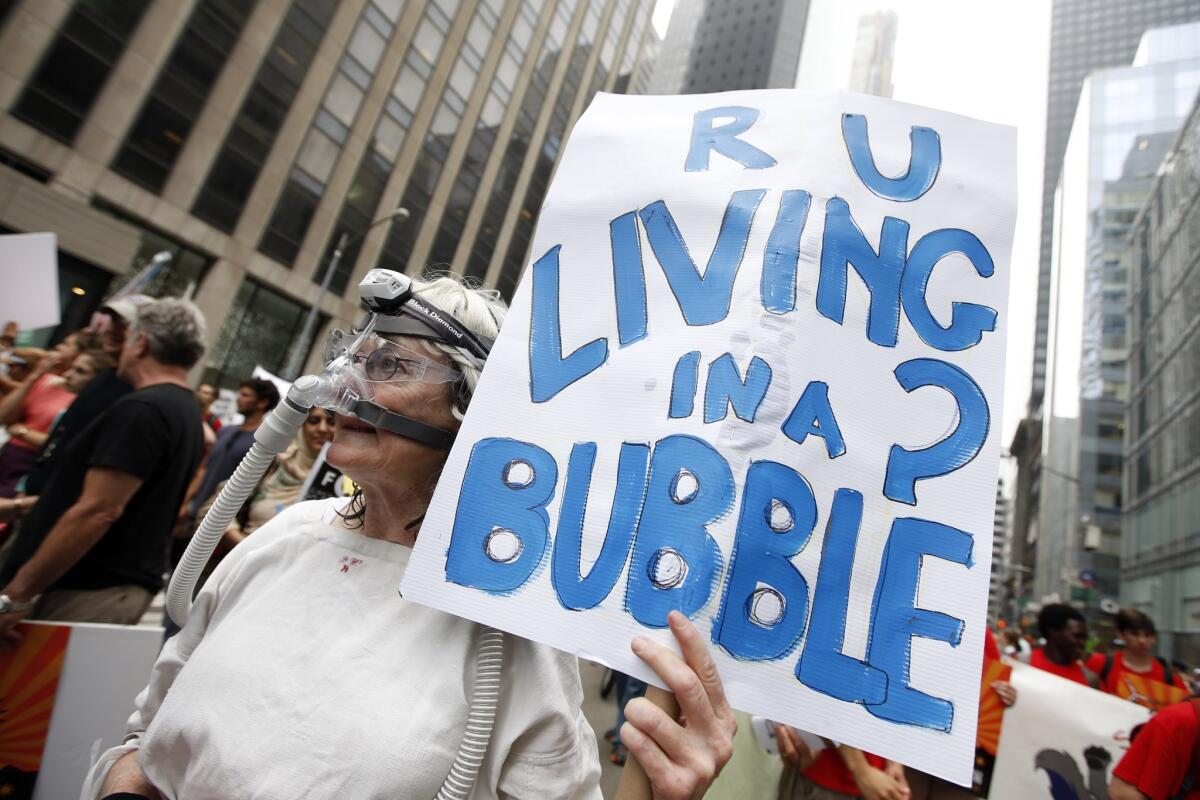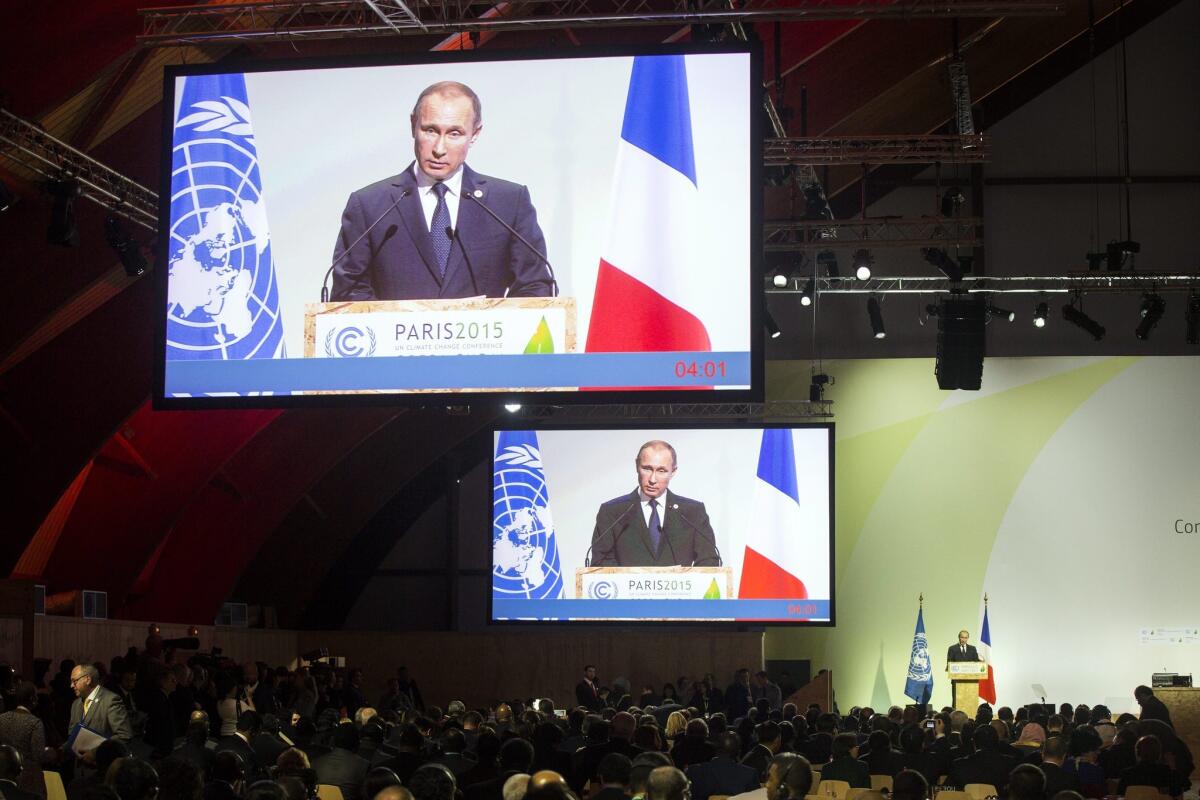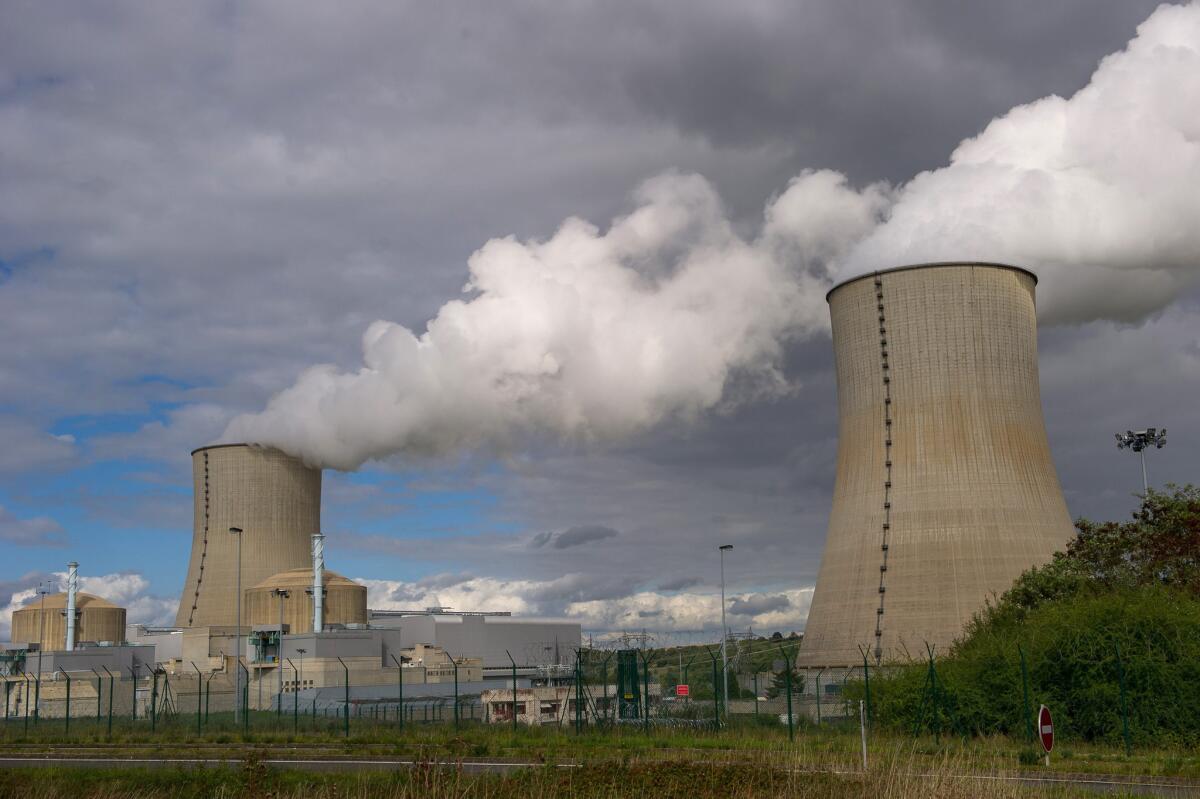Climate talks updates: Negotiators race to finish new draft for weekend
- Share via
Private talks are continuing at the United Nations Conference on Climate Change near Paris.
There were 150 world leaders there kicking off the gathering with an ambitious goal: to limit rising global temperatures this century to no more than 2 degrees Celsius above pre-industrial levels. In the first days of the conference , President Obama pushed for a pact even as the U.S. House moved to block climate rules at home.
California Gov. Jerry Brown delayed his arrival due to the shootings in San Bernardino, but the rest of the delegation is on the scene and embarks on a packed agenda Friday.
The Times is covering the negotiations, and reporter Chris Megerian is in Paris covering the delegation.
It's another day in Paris.
Follow along for new updates here.
Brown departs. Next stop: Paris
Delayed a day for his visit to the scene of Wednesday's mass shooting in San Bernardino, Gov. Jerry Brown left California midafternoon Friday for the climate summit in Paris.
As is the custom, his office sent out a simple message to reporters: "The governor has left the state."
Brown's first event when he arrives Saturday is scheduled to be a speech at COP21's "Action Day," highlighting climate change efforts on the national and state or local level.
His plans then call for him to join in a Saturday evening panel discussion after the screening of a new documentary, "Time to Choose."
In case you're wondering why Brown's office sent out the official notice: California law says the governor has to be inside state borders to be in charge. While Brown is in Paris, Lt. Gov. Gavin Newsom assumes authority.
L.A. Mayor Eric Garcetti in Paris
The California conversation, sans Jerry Brown
Gov. Jerry Brown may have been delayed in making his way to Paris, but California's role in the United Nations gathering is pretty far reaching, judging by the glimpses we're getting through social media.
The (almost) official delegation numbers about 40, but there are also several prominent business and local leaders on hand in the City of Light.
Los Angeles Mayor Eric Garcetti was spotted at Friday's gathering held by a group known as the Compact of Mayors , highlighting efforts in some 360 cities worldwide to reduce carbon emissions.
And he wasn't alone.
Oakland Mayor Libby Schaaf, second from left in the above photo, participated in a panel discussion Friday on business/government efforts on climate initiatives.
And, yes, the man with the microphone and wearing his favorite tartan tie: the ever-present billionaire environmental activist Tom Steyer.
Meantime, advisors to Gov. Brown made sure his presence was felt, even as the governor was delayed in arriving after the mass shootings in San Bernardino.
Brown had planned to meet with U.N. Secretary-General Ban Ki-moon on Friday.
In a photo posted by the Climate Group, an international nonprofit organization, it's clear California still had an important spot in that meeting with the secretary-general, who's in the center of the photo: Two seats to Ban's right is California Environmental Protection Agency Secretary Matt Rodriquez.
Learning the lingo
Keeping track of the negotiations at the United Nations summit in Paris requires deciphering the unique language of the conference. Here’s a quick glossary:
Contact groups -- Committees that are formed to concentrate on specific topics, such as financing environmental projects in the developing world.
Informal informals -- Small side meetings held by negotiators to nail down specific parts of a climate deal.
Nonpaper papers -- Proposals that are floated outside the normal negotiating process at the conference.
INDC to NDC -- Before the conference started, countries submitted their “intended nationally determined contributions,” or INDCs, which are proposals for what they can accomplish on controlling emissions. The goal is to drop the “I” so that INDCs become “nationally determined contributions,” or NDCs, in the final climate deal.
Pictures from the conference
Assembly Speaker Toni Atkins of San Diego posted these photos from Paris.
Protesters touch on degree issue as well
A matter of degree

Demonstrators make their way down Sixth Avenue in New York during the People’s Climate March on Sept. 21, 2014.
Here's a math problem that is confounding international climate negotiators: Which is better, 1.5 or 2 degrees Celsius?
The difference is just half a degree, but small nations say that, for them, it could mean the difference between life and death. For larger nations, the question is what's realistic and what's not when it comes to limiting global warming.
The broader issue is how much warming is too much. In 2010, international negotiators formally adopted a goal of limiting warming to 2 degrees Celsius (3.6 degrees Fahrenheit) over pre-industrial times; Earth has already warmed nearly 1 degree by now.
The warming goal is what experts call a guardrail, and it has the potential to derail the Paris climate talks if negotiators can't agree on a number.
Small island nations, such as the Marshall Islands, Tuvalu and St. Lucia, and some other countries are pushing 1.5 because they see that half a degree as an issue of survival. They talk about sea level rise inundating cities, salt water killing off crops, and more dangerous storms wiping out cities. And they have marshaled protesters to join in their effort.
"It's a fight that really should not be focused on numbers 1.5, 2, 2.5," said James Fletcher, St. Lucia's minister for sustainable development, energy, science and technology. "It should be focused on lives. We're not fighting for numbers, we're fighting for lives."
To climate scientists, who say both numbers are a bit arbitrary, keeping warming to 1.5 degrees could increase the chance of survival of coral reefs, slow the rise in the number of ever-increasing severe weather disasters, and help keep the planet from hitting dreaded, but so far unseen, tipping points of irreversible environmental damage.
"There is no such thing as a guardrail where we are free from all the impacts of climate change; we've already seen climate change and it's widespread," said Chris Field, a Carnegie Institution scientist who headed an international scientific assessment of climate impacts two years ago.
For some countries, keeping warming to 1.5 degrees may require too steep and painful cuts in carbon dioxide emissions from the burning of coal, oil and gas. But U.N. climate chief Christiana Figueres and climate talks President Laurent Fabius, the French foreign minister, were optimistic about compromise. So far, international negotiators trying to broker a deal say it's a challenge they think they can handle, maybe with some compromise.
"Whether the text will also take into account a very justifiable request from the most vulnerable countries to improve on those efforts, it remains to be seen how that is going to be handled," Figueres said in an interview with the Associated Press. "It wouldn't surprise me if there is a recognition of the intense vulnerability of some nations."
U.S. chief climate negotiator Todd Stern said his delegation has talked with the small islands about their desire for the 1.5-degree goal: "We haven't landed anywhere yet, but we hear the concerns of those countries and we think those concerns are legitimate."
Fletcher said he can see a compromise where both goals -- 2 and 1.5 -- are listed, saying they'll try to hit 1.5 but commit to 2 if they can't.
Then there's the question of whether either goal is attainable.
Andrew Jones, co-director of Climate Interactive, has run the numbers on his computer models that simulate how much the world warms based on how much carbon pollution is spewed.
He calls achieving a 2-degree goal difficult and a 1.5-degree goal "very difficult." His numbers show that current pledges by nations would only limit warming to 3.5 degrees, down from the current trajectory of 4.5 degrees if nations continue producing emissions as they have been.
For example, to do its part in keeping warming to 2 degrees, the United States must cut emissions by 4.1% a year by 2030, but to get to 1.5 degrees, it must cut emissions by 6.2% a year. Those cuts would need to increase even more between 2030 and 2050. The fastest a country has ever cut carbon emissions was about 4% a year during the 1970s oil crisis, when France switched heavily to nuclear power.
But Jones and MIT professor John Sterman said people shouldn't get bogged down in the numbers right now. They said it's like driving from New York City to San Francisco, arguing about where you are going to park when you get there when you are still only on the East Coast.
For his part, Field said it's a bit of an academic question, especially since the emissions already spewed stay around for so long that the world is nearly already committed to 1.5 degrees of warming.
"We're very, very close," Field said. "We're teetering on the edge of commitment to 1.5 degrees C," Field said. He added that he finds it difficult to imagine how the world can prevent 1.5 degrees of warming "without messing up the global economy, including people in developing countries."
Others, such as James Hansen, a former NASA climate chief turned activist, said 2 degrees is too much warming, calling it "a crazy target to have; you cannot say that's a safe guardrail."
Hansen, often considered the godfather of global warming science said "1.5 is certainly less dangerous than 2 degrees; I wouldn't even want to characterize that as a guardrail."
Hollywood in Paris
Actors Leonardo DiCaprio and Robert Redford were among those who made the trip to Paris this week to boost the climate talks.
Redford represented the National Resources Defense Council.
U.N. climate chief: Get some sleep

Russian President Vladimir Putin delivers a speech as he attends Heads of States’ Statements ceremony of the COP21 World Climate Change Conference 2015 north of Paris.
The head of the U.N. climate change agency says high-intensity negotiations in Paris are on track so far and that her biggest concern now is that negotiators get enough rest to stay focused.
Christina Figueres, chief of the U.N. Framework Convention on Climate Change, insisted that an international accord fighting global warming should include legally binding parts. She also said it's impossible to quantify how much it will cost the world to clean up and protect people affected by climate change.
Five days into the talks "we are where we thought we could be," Figueres told the Associated Press in an interview at the Paris talks, which are scheduled to end Dec. 11.
She said her greatest concern at this point is "that everyone remains focused, that everyone gets a least a minimum of sleep, that everyone remains healthy so that they can all do the work that needs to be done."
Figueres said the final climate pact should have "teeth" to ensure that countries fulfill their promises to cut carbon emissions, which scientists say are warming the Earth and causing increasing extreme weather such as droughts and floods.
"It is going to be legally binding. It does not mean that every element is going to be equally binding in the same way. Some elements are probably going to be internationally legally binding and some are going to be domestically legally binding," she said.
Many activists at the Paris conference are worried that the pact will not include commitments by rich countries to provide aid to poorer countries for the losses and damages they suffer because of climate change.
Figueres insisted there's no way to put a figure on how much that will cost.
"The long-term slow onset of climate change cannot be put into a numerical value ... because we don't really know how much damage can be done," she said. "More importantly, human life does not have a monetary value."
Counting sheep at the climate summit
California entrepreneurs push to reinvent the nuclear industry

A nuclear power plant at the edge of the Vienne River in western France.
A nuclear power plant at the edge of the Vienne River in western France. (Guillaume Souvant / AFP/Getty Images)
The state that spawned a generation of activists committed to shutting down nuclear reactors and crippling the industry has lately become a hotbed of advocacy and financial support for fighting global warming with, of all things, nuclear power.
Encouraged by the Obama administration, notable California innovators and financiers are looking to reinvent the industry in the mold of wind and solar power. They are betting on prototype technologies that seek to replace the hulking plants of today with smaller, nimbler units. Environmentally minded nuclear engineers argue that they can be designed so safely that they might be “huggable.” They talk of power plants that consume nuclear waste instead of creating it.
Crunch time for climate negotiators
Negotiators are cramming to finish a new draft of a potential agreement on climate change tonight in hopes of starting the next phase of negotiations this weekend.
“We’re not there yet,” said French Foreign Minister Laurent Fabius, who is playing a leadership role at the conference.
Officials from the United Nations, France and the United States were reluctant to detail any one sticking point in negotiations, saying there are many questions left to answer before the deadline.
“There is no one single factor that can be advanced without the others,” said Christiana Figueres, the top U.N. official for climate change. “This is very much a balancing act.”
Once a revised version of the agreement is finished, high-level talks can begin with the aim of reaching a final deal by the end of the conference on Dec. 11.
Some representatives from island nations have pushed for an acknowledgement that restricting global temperatures from rising any more than 1.5 degrees Celsius is necessary to prevent severe damage to their countries. The generally accepted target for negotiations is 2 degrees Celsius, although even that is considered to be a tough goal to hit.
Todd Stern, the lead U.S. negotiator, said American officials are still reviewing the latest version of the agreement, which was released on Friday.
“It’s certainly not the agreement we’re looking for in any number of ways,” he said.
Stern added, “I have high hopes it’s an agreement we will like in the end.”
California racks up the signatures on climate agreement
The agreement was first announced by California and the German state of Baden Württemberg in May.
Jerry Brown balances San Bernardino attack, Paris trip
As President Obama headed to Paris this week for the United Nations summit, some Republicans denounced his focus on climate change while the country faces terrorism threats.
Asked about the criticism in a Tuesday interview, Gov. Jerry Brown responded with the old adage about jumping rope and chewing gum.
“We have to be able to do at least two things,” he said.
One day later, the question of balancing terrorism and climate change became much less abstract for the governor — a husband and wife opened fire on an office gathering in San Bernardino on Wednesday, killing 14 and wounding 21. The couple had a small arsenal of weapons, and authorities are investigating whether they had ties to extremists.
Brown, who has made fighting climate change a priority for his administration, was originally supposed to leave for his own trip to Paris on Thursday, but instead he headed to San Bernardino to meet with law enforcement.
The governor is now expected to arrive in Paris on Saturday, when he’s scheduled to speak at the convention center where negotiators are working on a new international climate agreement.
So, who's paying for the trip?
Chris Megerian explains the business interests footing the bill for California's large delegation to attend the climate talks, and which lawmakers are in France for the week.
The start of a new day of negotiations
French police don't hesitate to use broad new emergency powers
A backdrop of the climate talks has been the reminder of the terrorist attack just a few weeks ago.
Some seemingly heavy-handed police operations have been drawing attention in France after 130 people were killed in shooting and bombing attacks in Paris on Nov. 13, prompting the introduction of a rash of security measures.
Day 5 begins
Sign up for Essential California
The most important California stories and recommendations in your inbox every morning.
You may occasionally receive promotional content from the Los Angeles Times.







